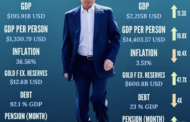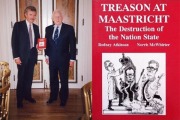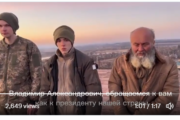INTRODUCTION by Rodney Atkinson: On this website we have frequently pointed to the logical consistency between the foreign policies of the evidently evil Nazi period in Germany (1933 to 1945) and the (ostensibly benign) periods which preceded and succeeded that time. The Bavarian State funding of the new Hitler-sympathetic film “The Fall” about Hitler’s last days in the Berlin bunker should come as no surprise since we have pointed to the corporatist nature of Bavarian politics before.
Hitler’s rise to power was based in Munich in Bavaria and after the war it was the Bavarian State which took the copyright of Mein Kampf, Hitler’s personal political manifesto. Bavaria and the German State have used that copyright to try to stop publication of the book by anti-Nazis – see in particular the “Swedish Mein Kampf Case” on http://www.ukconservatism.freeuk.com/archive5.htmlSuch attempts at censorship have usually proved futile, as, eventually, it did in Sweden)
The revisionist sympathies for the Nazi period expressed in a liberal paper originally established by the British as an anti Nazi publication reminds us of how in Germany nationalistic sympathies are far more often expressed by liberal and left wing figures and publications than in, say, Britain or America. The famous columnist for decades on the liberal weekly newspaper Die Zeit, Marion Graefin von Doenhoff, has given her name to a foundation which intends to “restore” former German owned properties in Poland. One property chosen for restoration, was part of her family’s aristocratic properties and served as the residence of National Socialist Foreign Minister Ribbentrop until 1944)
BERLIN (Translation of an article from german-foreign-policy.com)
The German media’s revisionist revaluation of the Nazi dictatorship has reached new heights and now includes “sympathy” and “empathy” for Adolf Hitler.
Apparently Hitler can now be regarded as having similar historical significance to the Prussian Frederick the Great – according to the Berlin press! This praise for the mass murderer (and anti semitic German imperialist) has been prompted by the release of a film about the final days of the Fuehrer which he spent with his entourage in the Berlin bunker at the end of the war. The film “The Fall” cost 13.5m Euros (£9m) and was part financed by the Bavarian State Film Corporation.
The German television rights have been bought by ARD the German equivalent of the BBC (ie set up under public law). The producer Bruno Ganz has said about the film: “The living Hitler before 1945 is different from the dead Hitler after 1945 – he was created by posterity”. The undisguised revision of German history has been accompanied by the honouring of Nazi collaborators in several East European States.
Empathy with the Fuehrer
One should not portray Hitler as a beast say those responsible for the film “The Fall”. They justify their current revision of history by “de-demonising” the past making possible a new “access” to events and personalities of the past. For example in regard to the nazis armaments policy in the run up to the Second World War Hitler had “in fact achieved considerable success in an unbelievably short time not only internally (from millions of unemployed to full employment (sic!)) but externally when Germany was internationally accepted as a State” (1) It was necessary to have “empathy with the Fuehrer” (2). Similar revisionist arguments are now seen often in the German media and are leading – in films and TV documentaries – to a gradual movement towards the historical analysis of Nazi sympathisers. (3) In particular for some time ther has been much coverage of the alleged “history of suffering” of the German people. (4)
Recognition for the Dictator
After the first previews of the film the German press wrote about the “sympathy which emerges because of the tragedy”. The intellectually serious Tagesspiegel (in fact founded by the British after the war as an anti-Hitler publication) even assigns to the “tragic” Hitler heroic qualities. “An isolated bellower, betrayed by the faithful but who maintained his poise to the end: Is that not a hero, indeed not so sympathetic as some of the few positive figures who surrounded him but for that reason more immortal?” The newspaper (circulation 143,000) considers a total revision of the Hitler image perfectly possible. “Will we not regard this German dictator in 200 years with the same recognition as Frederick the Great whose picture hung behind Hitler’s desk in his bunker?” (5) Asks the liberal Tagesspiegel.
SS Veterans Remembered
“Empathy” with Hitler’s regime is even promoted in those states which were prime collaborators with the Nazis. For example East European SS veterans openly acclaim their past activities and even hold parades to commemorate them. In the Estonian town of Lihula a monument has just been set up which portrays an Estonian soldier in Nazi uniform. It is supposed to celebrate baltic SS members in their fight against the Soviet Union which became an anti Hitler ally in 1941 and suffered 30 million dead.
The mayor of the town declared that the monument was dedicated to those who “had to choose between two evils and decided on the lesser”. Another monument for Estonian SS soldiers is to be erected in Tallinn, the capital. After the Nazi takeover 100,000 Estonians joined the Estonian Waffen SS and took part in the Nazis’ extermination policies. Circa 4,000 Estonian Jews were murdered. (6)
In neighbouring Latvia during the Nazi occupation some 70,000 lost their lives because they were classified as Jews. About 150,000 Latvians fought with the Nazis against the Soviet union most of them in the Waffen SS. A monument dedicate to the Latvian members of the SS was erected in November 2000 in the town of Lestene. A ceremony to dedicate the graveyard for the fallen of the Latvian SS was broadcast on Latvian television.
Among the guests which included MPs and former President Ulmanis were General Graube and the Minister of Culture, Mrs Ribena. The Chairman of the Latvian Soldiers Association and former Waffen SS soldier declared it a “Graveyard for Heroes – whether others like it or not”
The graveyard was set up with the help of the “German Association for the Care of War Graves” which among other help offers travel to the graves of SS soldiers, financed to the tune of several millions by the German Government. (7) German Government money even finds its way to former collaborators still alive. They qualify for a pension if they fought against the Allies “in military or quasi military service and suffered injury in an accident (for example through bombing or mines)”. Among those receiving such pensions are the former soldiers of the Waffen SS who fought in German service. (8)
1) Hitler spielen; Frankfurter Allgemeine Sonntagszeitung 22.08.2004
2) Einfühlung in den Führer; Berliner Zeitung 24.08.2004
3) s. auch Deutsche Kulturpolitik: Wiederkehr des Vergangenen und Wiederauferstehung sowie Deutsche Kultur: Wiederkehr des Vergangenen
4) s. auch Traumata und Lebensraum Osten
5) Der Übersterbensgroße; Tagesspiegel 24.08.2004. S. auch Denkmal für preußische Militärs: ,,Die Bande des Vorurteils lösen” und Denkmal für deutschen Geopolitiker
6) s. auch Minenhunde
7) s. auch Ehrung der Täter auf dem Friedhof der Opfer und Wehrpropaganda sowie Hintergrundbericht: Der Volksbund Deutsche Kriegsgräberfürsorge
8) s. auch Außenstelle
s. auch Déja vu















